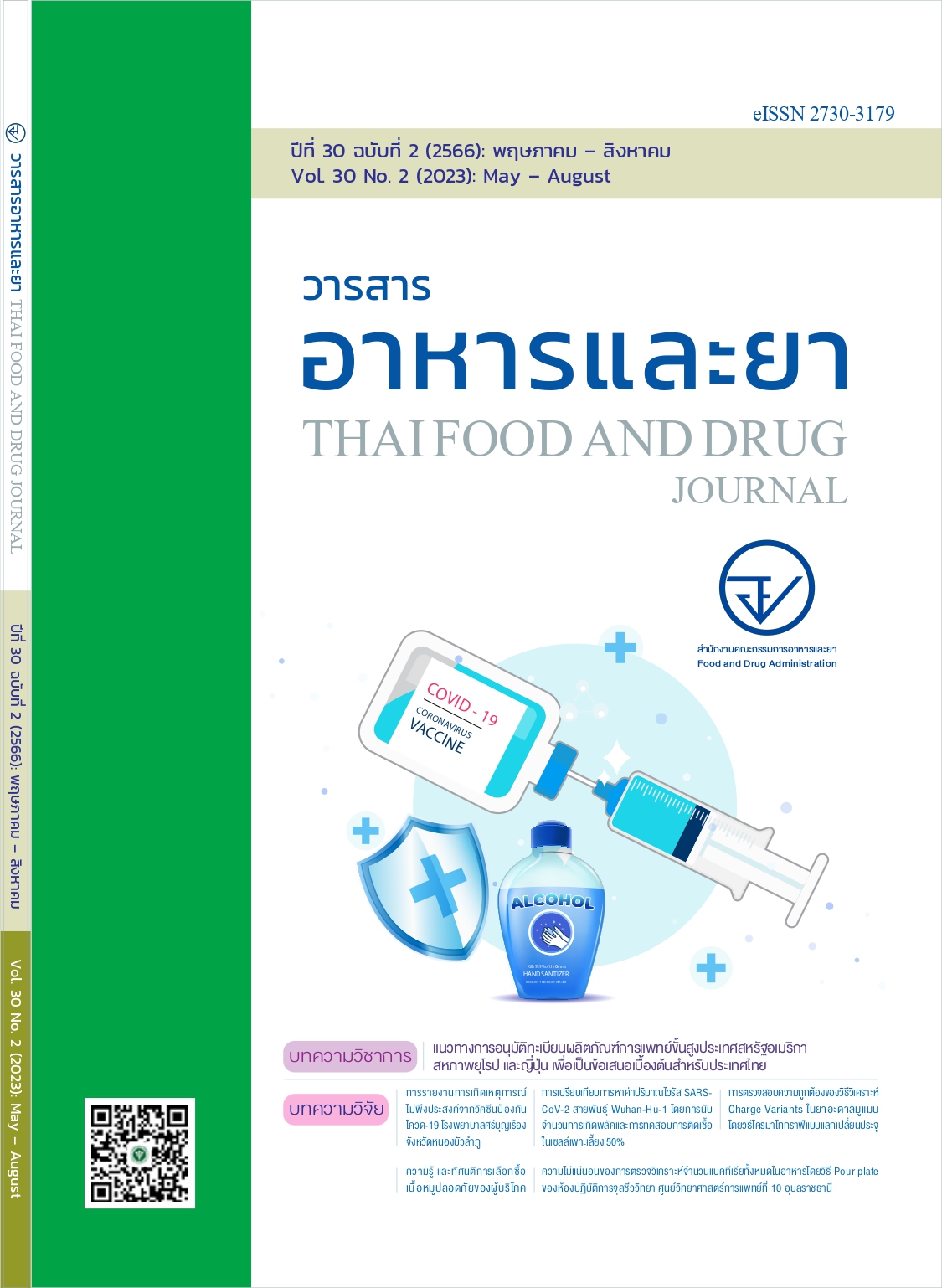การเปรียบเทียบการหาค่าปริมาณไวรัส SARS-CoV-2 สายพันธุ์ Wuhan-Hu-1 โดยการนับจำนวนการเกิดพลัคและการทดสอบการติดเชื้อในเซลล์เพาะเลี้ยง 50%
Main Article Content
บทคัดย่อ
ความสำคัญ: โรคติดเชื้อไวรัสโคโรนา-2019 (โควิด-19) ที่เกิดจากเชื้อไวรัส SARS-CoV-2 เป็นโรคอุบัติใหม่ที่หลายองค์กรพยายามพัฒนาวัคซีนหรือยาต้านไวรัสที่จำเพาะ จึงจำเป็นต้องมีการเพาะเลี้ยงเพื่อเพิ่มจำนวนและหาค่าปริมาณไวรัสเพื่อนำมาใช้ในการตรวจวิเคราะห์ทางห้องปฏิบัติการ การหาปริมาณไวรัสที่นิยมใช้กันมากมี 2 วิธีคือ การนับจำนวนการเกิดพลัค และการทดสอบการติดเชื้อในเซลล์เพาะเลี้ยง 50%
วัตถุประสงค์: เพื่อเปรียบเทียบและหาค่าปริมาณไวรัส SARS-CoV-2 สายพันธุ์ Wuhan-Hu-1 และความสิ้นเปลืองทรัพยากรที่ทำการทดสอบโดยวิธีการนับจำนวนการเกิดพลัค และการทดสอบการติดเชื้อในเซลล์เพาะเลี้ยง 50%
วิธีการวิจัย: เป็นการวิจัยเชิงทดลองระหว่างเดือนมีนาคม - มิถุนายน 2563 โดยเปรียบเทียบการหาปริมาณไวรัส SARS-CoV-2 สายพันธุ์ Wuhan-Hu-1 ระหว่างทั้งสองวิธีโดยใช้เชื้อไวรัสชุดเดียวกัน ทดสอบในช่วงเวลาเดียวกัน จำนวน 80 การทดสอบ
ผลการศึกษา: พบว่าผลจากการนับจำนวนการเกิดพลัค และการทดสอบการติดเชื้อในเซลล์เพาะเลี้ยง 50% มีค่าปริมาณไวรัสเฉลี่ยเท่ากับ 5.97 log PFU/ml และ 6.00 log CCID50/ml ตามลำดับ ทั้งสองวิธีมีค่าร้อยละสัมประสิทธิ์ความแปรปรวนของผลการทดสอบเท่ากับ 4.09 และ 3.29 ตามลำดับ จากการทดสอบทางสถิติด้วย paired - t test พบว่าทั้งสองวิธีไม่มีความแตกต่างกันอย่างมีนัยสำคัญทางสถิติที่ p-value > 0.5 โดยค่าอัตราส่วนระหว่างปริมาณไวรัสจากวิธีทั้งสองทั้งค่าเฉลี่ยเลขคณิตและค่าเฉลี่ยเรขาคณิตอยู่ระหว่าง 0.88 ถึง 1.14 โดยการทดสอบด้วยการทดสอบการติดเชื้อในเซลล์เพาะเลี้ยง 50% มีความรวดเร็วโดยใช้เวลาทดสอบเพียง 4 วันและประหยัดค่าใช้จ่ายในการใช้วัสดุ อุปกรณ์ และอาหารเลี้ยงเซลล์ที่น้อยกว่า
สรุปผล: การหาค่าปริมาณไวรัส SARS-CoV-2 ด้วยวิธีการนับจำนวนการเกิดพลัค และการทดสอบการติดเชื้อในเซลล์เพาะเลี้ยง 50% ให้ผลไม่แตกต่างกัน แต่การทดสอบการติดเชื้อในเซลล์เพาะเลี้ยง 50% มีความรวดเร็วและประหยัดค่าใช้จ่ายกว่า สามารถนำวิธีทั้งสองไปใช้ในการหาปริมาณไวรัส SARS-CoV-2 และพัฒนาการตรวจหาภูมิคุ้มกันต่อเชื้อไวรัส SARS-CoV-2 ในผู้ป่วย รวมถึงเพื่อทดสอบประสิทธิภาพของวัคซีนในการป้องกันโรคโควิด-19 ทั้งในสัตว์ทดลองและมนุษย์ต่อไปได้
Article Details

อนุญาตภายใต้เงื่อนไข Creative Commons Attribution 4.0 International License.
เอกสารอ้างอิง
Hui DS, I Azhar E, Madani TA, Ntoumi F, Kock R, Dar O, Ippolito G, Mchugh TD, Memish ZA, Drosten C, Zumla A, Petersen E. The continuing 2019-nCoV epidemic threat of novel coronaviruses to global health - The latest 2019 novel coronavirus outbreak in Wuhan, China. Int J Infect Dis 2020;91:264-66.
Wong ACP, Li X, Lau SKP, Woo PCY. Global Epidemiology of Bat Coronaviruses. Viruses 2019 20;11(2):174.
Sexton NR, Smith EC, Blanc H, Vignuzzi M, Peersen OB, Denison MR. Homology-Based Identification of a Mutation in the Coronavirus RNA-Dependent RNA Polymerase That Confers Resistance to Multiple Mutagens. J Virol 2016;90(16):7415-7428.
World Health Organization. WHO announces COVID-19 outbreak a pandemic [Internet]. WHO; 2020 [cited 2020 Jun 12]. Available from: http://www.euro.who.int/en/health-topics/health-emergencies/coronavirus-covid-19/news/news/2020/3/who-announces-covid-19-outbreak-a-pandemic
Steenhuysen, Julie; Kelland, Kate. "With Wuhan virus genetic code in hand, scientists begin work on a vaccine". Thomson Reuters (25 January 2020). [cited 12 June 20]; [screens]. Available from: URL: Available from: https://www.reuters.com/article/us-china-health-vaccines/with-wuhan-virus-genetic-code-in-hand-scientists-begin-work-on-a-vaccine-idUSKBN1ZN2J8
Fukuda A, Sengün F, Sarpay HE, Konobe T, Saito S, Umino Y, Kohama T. Parameters for plaque formation in the potency assay of Japanese measles vaccines. J Virol Methods 1996;61(1-2):1-6.
World Health Organization. WHO. Requirements for varicella vaccine (live). Technical Report Series No. 848. 1994; Annex 1.
Husson-van Vliet J, Colinet G, Yane F, Lemoine P. A simplified plaque assay for varicella vaccine. J Virol Methods 1987;18(2-3):113-20.
Forcic D, Kosutić-Gulija T, Santak M, Jug R, Ivancic-Jelecki J, Markusic M, Mazuran R. Comparisons of mumps virus potency estimates obtained by 50% cell culture infective dose assay and plaque assay. Vaccine 2010;17;28(7):1887-92.
Covid 19 Vaccine tracker. Approved Vaccines; [update 2022 Oct 28; cite 2022 Oct 30]. Available from: https://covid19.trackvaccines.org/vaccines/approved/#vaccine-list
กระทรวงการอุดมศึกษา วิทยาศาสตร์ วิจัยและนวัตกรรม. อว. เผยความก้าวหน้าของการวิจัยวัคซีนโควิด 19 โดยนักวิจัยไทยความคาดหวังของประเทศ [อินเทอร์เน็ต]. 2564 [วันที่ปรับปรุง 15 เม.ย. 2564; เข้าถึงเมื่อ 30 ต.ค. 2565]. เข้าถึงได้จาก: https://www.mhesi.go.th/index.php/en/content_page/item/4228-168641.html
Recommendation for Japanese encephalitis vaccine (inactivated) for human use (revised 2007). WHO Expert Committee on Biological Standardization.2007; Annex 1
Guidelines for the production and control of Japanese Encephalitis vaccine (live) for human use. Technical Report Series No. 910. 2002; Annex 3.
Requirements for measles, mumps and rubella vaccines and combined vaccines (live). In: WHO Expert Committee on Biological Standardization. WHO Technical Report Series No. 840. 1994; 102-201.
Requirements for poliomyelitis vaccine (Oral). In: WHO Expert Committee on Biological Standardization. WHO Technical Report Series No. 800. 1990.
Cooper PD. The plaque assay of animal viruses. Adv Virus Res 1961;8:319-78.
Yan C, Cui J, Huang L, Du B, Chen L, Xue G, et al. Rapid and visual detection of 2019 novel coronavirus (SARS-CoV-2) by a reverse transcription loop-mediated isothermal amplification assay. Clin Microbiol Infect 2020;26(6):773-779.
Shurtleff AC, Bloomfield HA, Mort S, Orr SA, Audet B, Whitaker T, et al. Validation of the Filovirus Plaque Assay for Use in Preclinical Studies [Internet]. 2016 [cited 12 Jun 2020]; [screens]. Available from: https://www.ncbi.nlm.nih.gov/pmc/articles/PMC4848606/
Smither SJ, Lear-Rooney C, Biggins J, Pettitt J, Lever MS, Olinger GG Jr. Comparison of the plaque assay and 50% tissue culture infectious dose assay as methods for measuring filovirus infectivity. J Virol Methods. 2013 Nov;193(2):565-71.
Freshey RI. Culture of animal cells: A Manual of Basic Technology (4th ed), Wiley-Liss, Inc 1994;290-96.
Low IE. Mycoplasma in tissue culture: Overview of detection methods. Health Lab Sci 1976; 13(2):129-36.
Chen TR. In situ detection of mycoplasma contamination in cell cultures by fluorescent Hoechst 33258 stain. Exp Cell Res 1977;104(2): 255-62.
Shurtleff AC, Biggins JE, Keeney AE, Zumbrun EE, Bloomfield HA, Kuehne A, et al. Standardization of the Filovirus Plaque Assay for Use in Preclinical Studies. Viruses 6;4(12):3511-30.
Ramakrishnan MA. Determination of 50% endpoint titer using a simple formula. World J Virol 2016;5(2):85-6.
Niroumand H, Zain MFM, Jamil M. Statistical methods for comparison of data sets of construction methods and building evaluation. Procedia Soc Behav Sci 2013;89:218-21.
Onen EA, Sonmez k, Yildirim F,Demirci EK, Gurel A. Development, analysis, and preclinical evaluation of inactivated vaccine candidate for prevention of Covid-19 disease. All Life 2022; 15(1):771-93.
Saadi J, Oueslati S, Bellanger L, Gallais F, Dortet L,Roque – Afonso AM, et al. Quantitative Assessment of SARS-CoV-2 Virus in Nasopharyngeal Swabs Stored in Transport Medium by a Straightforward LC-MS/MS Assay Targeting Nucleocapsid, Membrane, and Spike Proteins. J Proteome Res. 2021;20(2):1434–443.


